Heat Hazard Control in High-Temperature Tunnels: Experimental Study of Coupled Cooling with Ventilation and Partial Insulation for Synergistic Geothermal Extraction
Abstract
:1. Introduction
2. Partial Thermal Insulation Technical Solutions and Advantages
2.1. Partial Thermal Insulation Design
2.2. Prospects, Values, and Limitations
3. Description of Similarity Experiment
- (1)
- The rock material is a homogeneous medium and the roughness is ignored.
- (2)
- Ignore the effect of humidity on heat transfer.
- (3)
- Ignore local heat dissipation by personnel and machinery.
3.1. Selection of Similarity Parameters
- (2)
- Realizable k-ε turbulence equation [52]:
- (1)
- Heat transfer within the rock [53]:
- (2)
- Heat transfer between fluids [54]:
- (3)
- Heat exchange at fluid-solid coupling interfaces [55]:
3.2. Composition of the Test Platform
3.2.1. Test Platform Dimensions and Layout
3.2.2. Monitoring Scheme
3.3. Test Strategy
4. Analysis of the Temperature Field in the Partial Insulated Tunnel
4.1. Partial Thermal Insulation Effect
4.2. Temperature Field Distribution of Partially Insulated Tunnel
5. Analysis of the Coupling Effect of Ventilation and Partial Thermal Insulation
5.1. Effect on Cooling Limit
5.2. Effect of Ventilation Speed
5.3. Effect of Surrounding Rock Temperature
5.4. Effect of Single and Double Heat Exchange Layer on Cooling Effect
5.5. Effect of Heat Exchanger Pipe Arrangement Density on Cooling Effect
6. Conclusions
- (1)
- The concept of coupled cooling of ventilation and partial thermal insulation is proposed. The precise insulation of the working area can effectively enhance the ventilation cooling effect and improve the tunnel environment, while saving insulation materials and reducing the unnecessary investment in the tunnel construction.
- (2)
- By constructing a test platform for coupled cooling of ventilation and thermal insulation, it was confirmed that the construction of partial insulation can improve the high-temperature environment in the working area. The construction of partial insulation makes the temperature field in the tunnel appear higher at the top than at the bottom and the difference lower at the front than at the back. When ventilation and partial heat insulation are coupled to reduce temperature, the partial thermal insulation layer can make the ventilation cooling limit decrease. The average temperature of the working area is reduced by 1.6 °C.
- (3)
- The ventilation velocity and the temperature of the surrounding rock are important factors affecting the coupled cooling effect of ventilation and partial thermal insulation. As the air velocity increases, the cooling effect gradually increases, and the thermal insulation effect gradually decreases. As the temperature of the surrounding rock increases, the efficiency of the coupled cooling of ventilation and partial thermal insulation decreases.
- (4)
- The further addition of a heat exchange layer on top of the insulation layer can achieve a better cooling effect and realize the synergistic exploitation of geothermal energy. The cooling effect is proportional to the length of the heat exchanger tube, and the best heat energy extraction effect is achieved by the double heat insulation layer, which can extract about 4.5 × 108 J of heat energy in 1 year of operation.
Author Contributions
Funding
Institutional Review Board Statement
Informed Consent Statement
Data Availability Statement
Conflicts of Interest
References
- Zhu, S.; Cheng, J.; Song, W.; Borowski, M.; Zhang, Y.; Yu, B.; Wang, Y.; Qi, C.; Tukkaraja, P.; Hua, G.; et al. Using seasonal temperature difference in underground surrounding rocks to cooling ventilation airflow: A conceptual model and simulation study. Energy Sci. Eng. 2020, 8, 3457–3475. [Google Scholar] [CrossRef] [Green Version]
- Chu, Z.; Zhou, G.; Rao, Z.; Wang, Y.; Zhao, X. Field measurement and assessment on airflow thermodynamic parameters in hot and humid underground tunnelling: A case study. Tunn. Undergr. Space Technol. 2022, 121, 104341. [Google Scholar] [CrossRef]
- Xu, Y.; Li, Z.; Wang, J.; Chen, Y.; Li, R.; Wang, Q.; Jia, M. Ventilation and heat exchange characteristics in high geotemperature tunnels considering buoyancy-driven flow and groundwater flow. Int. J. Therm. Sci. 2022, 173, 107400. [Google Scholar] [CrossRef]
- Wang, M.; Hu, Y.; Wang, Q.; Tian, H.; Liu, D. A study on strength characteristics of concrete under variable temperature curing conditions in ultra-high geothermal tunnels. Constr. Build. Mater. 2019, 229, 116989. [Google Scholar] [CrossRef]
- Liu, W.; Liang, S.; Shi, C. Risk modelling and simulation of thermal safety in underground railway tunnel surrounding. Accid. Anal. Prev. 2022, 168, 106620. [Google Scholar] [CrossRef] [PubMed]
- Lin, M.; Zhou, P.; Jiang, Y.; Zhou, F.; Lin, J.; Wang, Z. Numerical investigation on comprehensive control system of cooling and heat insulation for high geothermal tunnel: A case study on the highway tunnel with the highest temperature in China. Int. J. Therm. Sci. 2022, 173, 107385. [Google Scholar] [CrossRef]
- Yunpeng, H.; Mingnian, W.; Qiling, W.; Dagang, L.; Jianjun, T. Field test of thermal environment and thermal adaptation of workers in high geothermal tunnel. Build. Environ. 2019, 160, 106174. [Google Scholar] [CrossRef]
- Lee, J.; Lee, W.; Choi, W.-J.; Kang, S.-K.; Ham, S. Association between Exposure to Extreme Temperature and Injury at the Workplace. Int. J. Environ. Res. Public Health 2019, 16, 4955. [Google Scholar] [CrossRef] [Green Version]
- Bidassey-Manilal, S.; Wright, C.Y.; Engelbrecht, J.C.; Albers, P.N.; Garland, R.M.; Matooane, M. Students’ Perceived Heat-Health Symptoms Increased with Warmer Classroom Temperatures. Int. J. Environ. Res. Public Health 2016, 13, 566. [Google Scholar] [CrossRef] [Green Version]
- Mohammadnia, A.; Ziapour, B.M.; Sedaghati, F.; Rosendahl, L.; Rezania, A. Fan operating condition effect on performance of self- cooling thermoelectric generator system. Energy 2021, 224, 120177. [Google Scholar] [CrossRef]
- Wang, Y. Case study on ventilation and cooling control technology of multi heat source coupling in long distance subsea tunnel construction. Case Stud. Therm. Eng. 2021, 26, 101061. [Google Scholar] [CrossRef]
- Chen, Q.; Zhang, H.; Zhu, Y.; Chen, S.; Ran, G. Study on distributions of airflow velocity and convective heat transfer coefficient characterizing duct ventilation in a construction tunnel. Build. Environ. 2021, 188, 107464. [Google Scholar] [CrossRef]
- Wang, K.; Li, Q.; Wang, J.; Yang, S. Thermodynamic characteristics of deep space: Hot hazard control case study in 1010-m-deep mine. Case Stud. Therm. Eng. 2021, 28, 101656. [Google Scholar] [CrossRef]
- Qiaoyun, H.; Yi, Z.; Kongqing, L.; Shenghua, Z. Computational evaluation of cooling system under deep hot and humid coal mine in China: A thermal comfort study. Tunn. Undergr. Space Technol. 2019, 90, 394–403. [Google Scholar] [CrossRef]
- Bornman, W.; Dirker, J.; Arndt, D.C.; Meyer, J.P. Integrated energy simulation of a deep level mine cooling system through a combination of forward and first-principle models applied to system-side parameters. Appl. Therm. Eng. 2017, 123, 1166–1180. [Google Scholar] [CrossRef] [Green Version]
- Li, X.; Fu, H. Development of an Efficient Cooling Strategy in the Heading Face of Underground Mines. Energies 2020, 13, 1116. [Google Scholar] [CrossRef] [Green Version]
- Luo, X.; Wang, Y.; Zhao, J.; Chen, Y.; Mo, S.; Gong, Y. Grey relational analysis of an integrated cascade utilization system of geothermal water. Int. J. Green Energy 2014, 13, 14–27. [Google Scholar] [CrossRef]
- Buhmann, P.; Moormann, C.; Westrich, B.; Pralle, N.; Friedemann, W. Tunnel geothermics—A German experience with renewable energy concepts in tunnel projects. Géoméch. Energy Environ. 2016, 8, 1–7. [Google Scholar] [CrossRef]
- Zhang, G.; Xia, C.; Zhao, X.; Zhou, S. Effect of ventilation on the thermal performance of tunnel lining GHEs. Appl. Therm. Eng. 2016, 93, 416–424. [Google Scholar] [CrossRef]
- Yang, C.; Peng, F.-L.; Xu, K.; Zheng, L.-N. Feasibility study on the geothermal utility tunnel system. Sustain. Cities Soc. 2019, 46, 101445. [Google Scholar] [CrossRef]
- Xu, Y.; Li, Z.; Chen, Y.; Jia, M.; Zhang, M.; Li, R. Synergetic mining of geothermal energy in deep mines: An innovative method for heat hazard control. Appl. Therm. Eng. 2022, 210, 118398. [Google Scholar] [CrossRef]
- Zhang, G.; Cao, Z.; Wang, W.; Mei, X.; Zhao, X.; Shen, S.; Na, T. Field test and numerical investigation on thermal environment of tunnel with air layer structure. Build. Environ. 2021, 203, 108105. [Google Scholar] [CrossRef]
- Kang, F.; Li, Y.; Tang, C. Numerical study on airflow temperature field in a high-temperature tunnel with insulation layer. Appl. Therm. Eng. 2022, 179, 115654. [Google Scholar] [CrossRef]
- Yao, W.; Lyimo, H.; Pang, J. Evolution regularity of temperature field of active heat insulation roadway considering thermal insulation spraying and grouting: A case study of Zhujidong Coal Mine, China. High Temp. Mater. Process. 2021, 40, 151–170. [Google Scholar] [CrossRef]
- Szlązak, N.; Obracaj, D.; Swolkień, J. Thermal Insulation of Excavations and Its Effect on Climate Conditions. Energies 2021, 14, 4170. [Google Scholar] [CrossRef]
- Dalla Santa, G.; Galgaro, A.; Sassi, R.; Cultrera, M.; Scotton, P.; Mueller, J.; Bertermann, D.; Mendrinos, D.; Pasquali, R.; Perego, R.; et al. An updated ground thermal properties database for GSHP applications. Geothermics 2020, 85, 101758. [Google Scholar] [CrossRef]
- Zhu, J.; Liu, Q.; Ju, Q.; Fan, J. Geothermal distribution and thermal damage prediction in Xutuan Coal Mine. Coal Eng. 2021, 53, 131–135. (In Chinese) [Google Scholar]
- Amiri, L.; Ghoreishi-Madiseh, S.A.; Sasmito, A.P.; Hassani, F.P. Effect of buoyancy-driven natural convection in a rock-pit mine air preconditioning system acting as a large-scale thermal energy storage mass. Appl. Energy 2018, 221, 268–279. [Google Scholar] [CrossRef]
- Galgaro, A.; Dalla Santa, G.; Cola, S.; Cultrera, M.; De Carli, M.; Conforti, F.; Scotton, P.; Viesi, D.; Fauri, M. Underground warehouses for food storage in the Dolomites (Eastern alps-Italy) and energy efficiency, Tunn. Undergr. Sp. Tech. 2020, 102, 103411. [Google Scholar] [CrossRef]
- Xu, Y.; Li, Z.; Liu, H.; Jia, M.; Wang, Q.; Zhang, M.; Xu, Y. Modeling of the dynamic behaviors of heat transfer during the construction of roadway using moving mesh. Case Stud. Therm. Eng. 2021, 26, 100958. [Google Scholar] [CrossRef]
- Li, Z.; Liu, H.; Xu, Y.; Li, R.; Jia, M.; Zhang, M. Numerical Analysis on the Thermal Performance in an Excavating Roadway with Auxiliary Ventilation System. Int. J. Environ. Res. Public Health 2021, 18, 1184. [Google Scholar] [CrossRef]
- Wang, H.; Zhou, Q. Finite Element Analysis of Surrounding Rock with a Thermal Insulation Layer in a Deep Mine. Math. Probl. Eng. 2020, 2020, 5021853. [Google Scholar] [CrossRef]
- Tu, R.; Huang, L.; Jin, A.; Zhang, M.; Hai, X. Characteristic studies of heat sources and performance analysis of free-cooling assisted air conditioning and ventilation systems for working faces of mineral mines. Build. Simul. 2021, 14, 1725–1736. [Google Scholar] [CrossRef]
- Fang, Y.; Yao, Z.; Lei, S. Air flow and gas dispersion in the forced ventilation of a road tunnel during construction. Undergr. Space 2019, 4, 168–179. [Google Scholar] [CrossRef]
- Hou, C.; Xin, S.; Zhang, L.; Liu, S.; Zhang, X. Foundation Research on Physicochemical Properties of Mine Insulation Materials. Coatings 2020, 10, 355. [Google Scholar] [CrossRef] [Green Version]
- Zhang, Y.; Lu, S.; Zhang, X.; Gao, Y.; Jia, Y. Development of a novel heat barrier coating for deep mining application. Aust. J. Mech. Eng. 2018, 16, 112–116. [Google Scholar] [CrossRef]
- Jiang, Y.; Xin, S.; Li, H.; Zhang, L.; Hou, C.; Zhang, Z.; Guo, J. Performance of Heat-Insulating Materials Doped with Basalt Fibres for Use in Mines. Polymers 2020, 12, 2057. [Google Scholar] [CrossRef]
- Wang, Y.; Wang, C.; Gao, S.; Zheng, X.; Darkwa, J. The impact of thermal insulation on cooling energy consumption and optimal insulation thickness for underground tunnel. Sustain. Energy Technol. Assess. 2021, 47, 101495. [Google Scholar] [CrossRef]
- Lakatos, Á.; Csík, A. Multiscale Thermal Investigations of Graphite Doped Polystyrene Thermal Insulation. Polymers 2022, 14, 1606. [Google Scholar] [CrossRef]
- Tlaiji, G.; Pennec, F.; Ouldboukhitine, S.; Ibrahim, M.; Biwole, P. Hygrothermal performance of multilayer straw walls in different climates. Constr. Build. Mater. 2022, 326, 126873. [Google Scholar] [CrossRef]
- Wang, J.; Wan, Z.; Zhang, H.; Wu, D.; Zhang, Y.; Wang, Y.; Xiong, L.; Wang, G. Application of Thermal Insulation Gunite Material to the High Geo-Temperature Roadway. Adv. Civ. Eng. 2020, 2020, 8853870. [Google Scholar] [CrossRef]
- Jia, M.; Chen, Y.; Wu, L.; Wang, S.; Jian, C. Design of metal mine deep mining roadway thermal exchange simulation test platform. Met. Mine 2014, 14, 113–116. (In Chinese) [Google Scholar]
- Zeng, Y.; Tao, L.; Ye, X.; Zhou, X.; Fang, Y.; Fan, L.; Liu, X.; Yang, Z. Temperature reduction for extra-long railway tunnel with high geotemperature by longitudinal ventilation. Tunn. Undergr. Space Technol. 2020, 99, 103381. [Google Scholar] [CrossRef]
- Liu, K.; Guo, J.; Wan, L.; Xu, C. A model test study to optimize the ventilation system of a long expressway tunnel. J. Wind. Eng. Ind. Aerodyn. 2020, 207, 104393. [Google Scholar] [CrossRef]
- Kalman, H.; Portnikov, D. Analyzing bulk density and void fraction: A. the effect of archimedes number. Powder Technol. 2021, 381, 477–487. [Google Scholar] [CrossRef]
- Lee, J.-C.; Bang, K.-S.; Yu, S.-H.; Choi, W.-S.; Ko, S. Similarity analysis of thermal-fluid flow for thermal testing using scaled-down model of spent fuel storage cask. Ann. Nucl. Energy 2020, 149, 107791. [Google Scholar] [CrossRef]
- Ocипoвa, B.A. Experimental Research on Heat Transfer, 1st ed.; Higher Education Press (Chinese Translation): Beijing, China, 1982. [Google Scholar]
- Shah, N.A.; Animasaun, I.; Ibraheem, R.; Babatunde, H.; Sandeep, N.; Pop, I. Scrutinization of the effects of Grashof number on the flow of different fluids driven by convection over various surfaces. J. Mol. Liq. 2018, 249, 980–990. [Google Scholar] [CrossRef]
- Paradis, P.; Champliaud, H. New correlations for heat transfer in parallel-plate ducts at low Peclet number. Int. J. Heat Mass Transf. 2021, 178, 121595. [Google Scholar] [CrossRef]
- Haymes, R.; Gal, E. Iterative multi-scale approach for heat conduction with free convection problem in periodic hollow structures. Int. J. Therm. Sci. 2020, 158, 106519. [Google Scholar] [CrossRef]
- Xiu, Z.; Nie, W.; Yan, J.; Chen, D.; Cai, P.; Liu, Q.; Du, T.; Yang, B. Numerical simulation study on dust pollution characteristics and optimal dust control air flow rates during coal mine production. J. Clean. Prod. 2020, 248, 119197. [Google Scholar] [CrossRef]
- Li, Z.; Wang, J.; Zhao, S.; Xu, Y. The effect of oxygen supply and oxygen distribution on single-head tunnel with different altitudes under mixed ventilation. Indoor Built Environ. 2022, 31, 972–987. [Google Scholar] [CrossRef]
- Suresh, C.; Sundararajan, T.; Venkateshan, S.; Das, S.K.; Thansekhar, M. Heat transfer from a totally blocked fuel subassembly of a liquid metal fast breeder reactor: II. Numerical simulation. Nucl. Eng. Des. 2005, 235, 885–895. [Google Scholar] [CrossRef]
- Freire, A.D.J.; Alexandre, J.L.C.; Silva, V.B.; Couto, N.D.; Rouboa, A. Compact buried pipes system analysis for indoor air conditioning. Appl. Therm. Eng. 2013, 51, 1124–1134. [Google Scholar] [CrossRef]
- Chen, G.; Wang, Y.; Tang, L.; Wang, K.; Yu, Z. Large eddy simulation of thermally induced oscillatory flow in a thermoacoustic engine. Appl. Energy 2020, 276, 115458. [Google Scholar] [CrossRef]
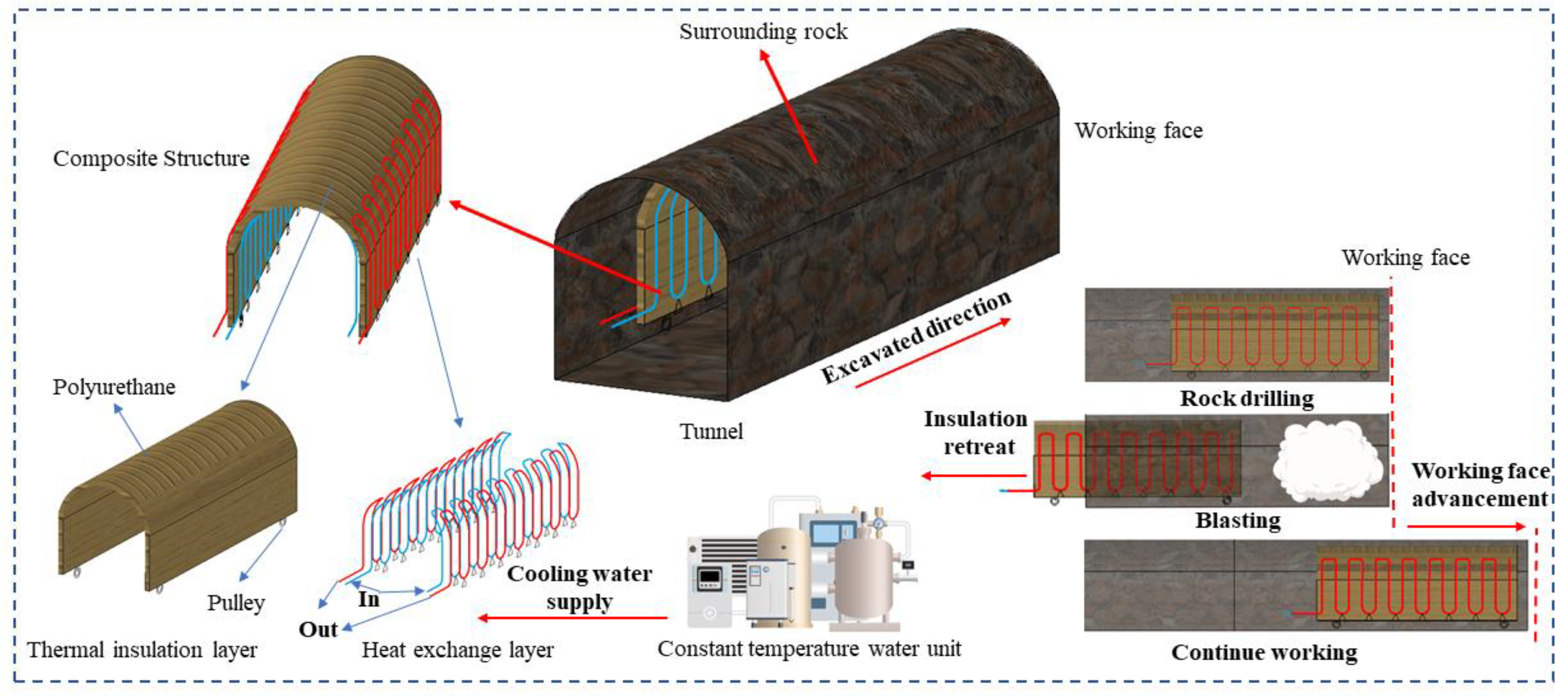
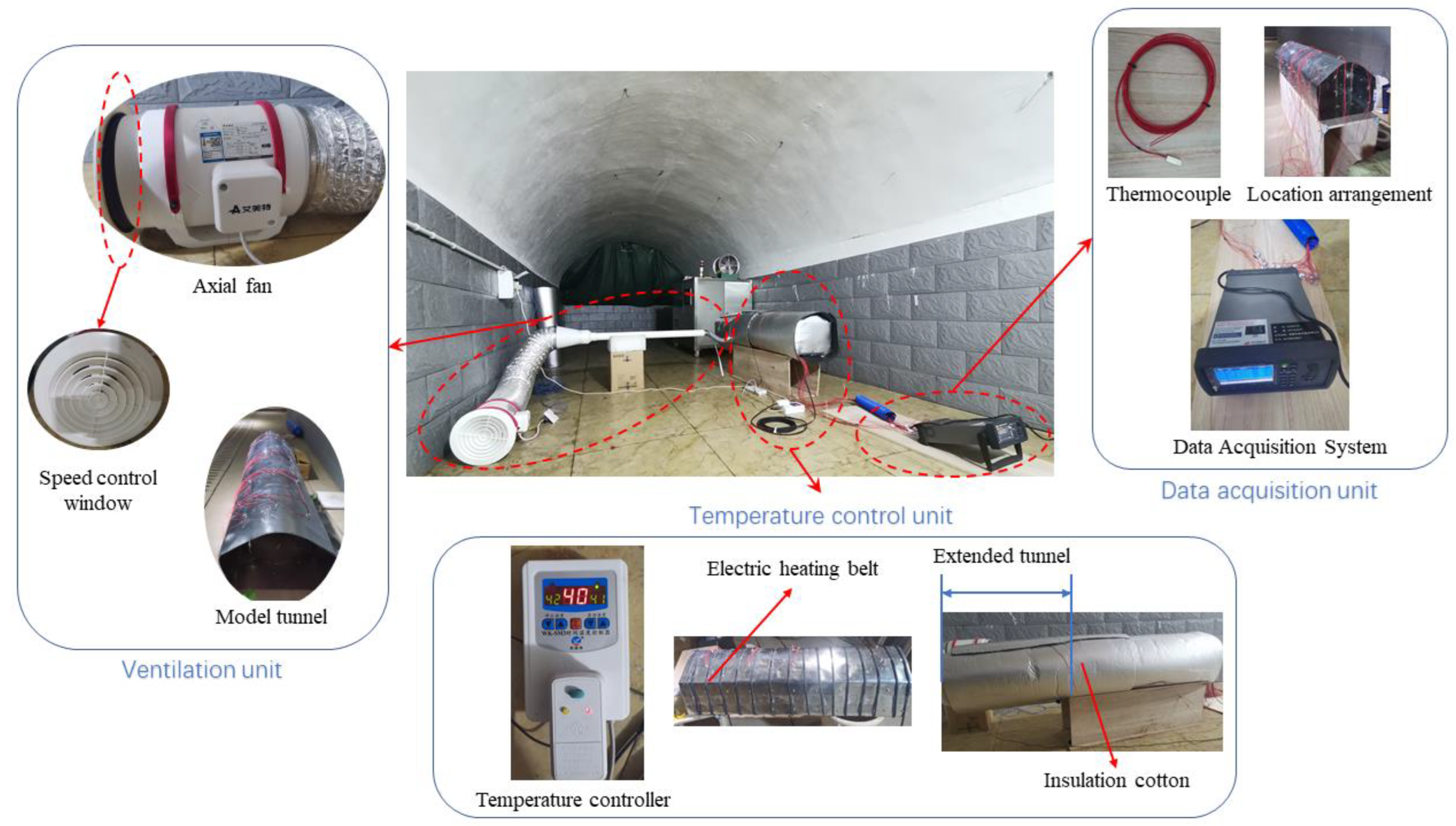


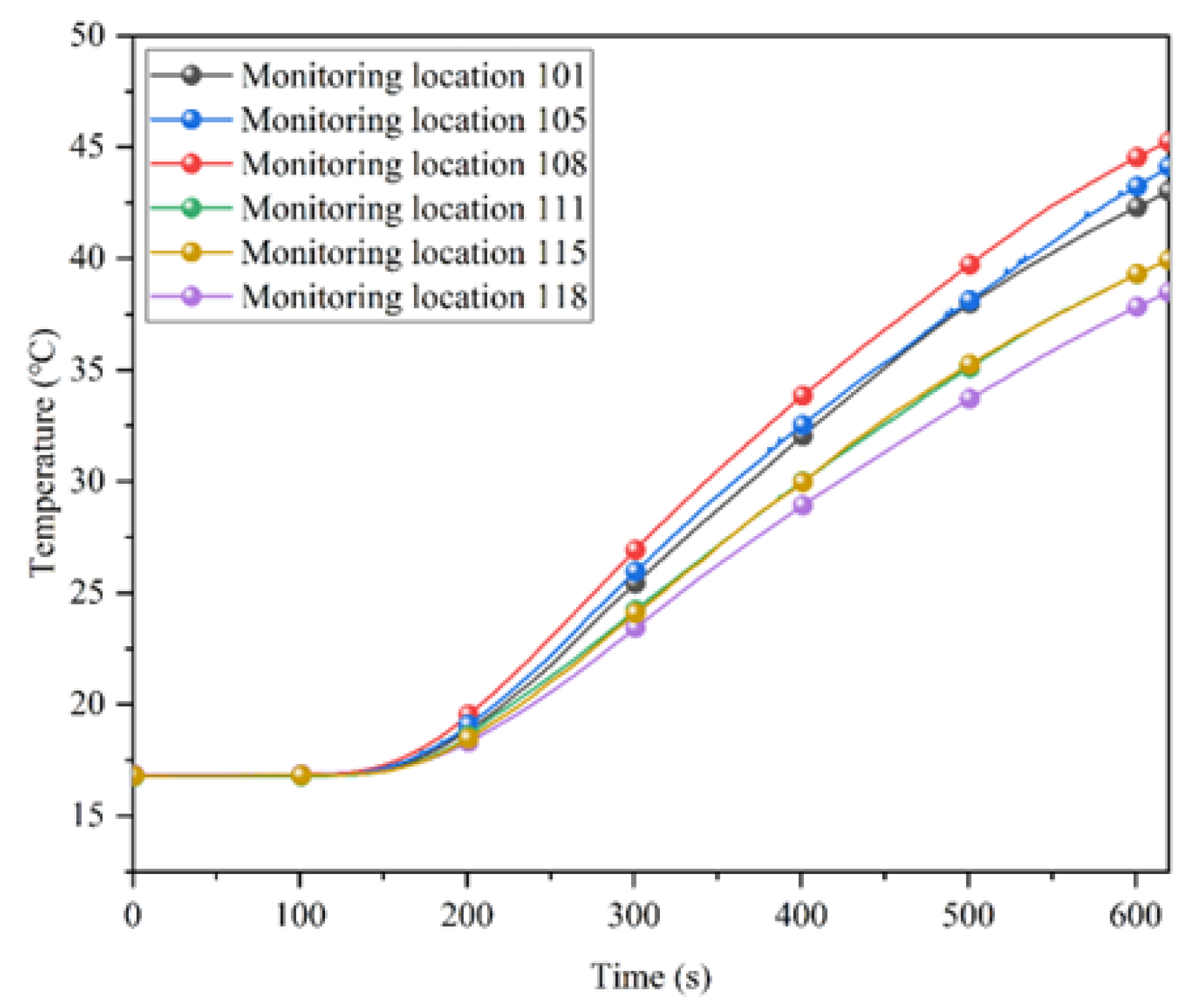
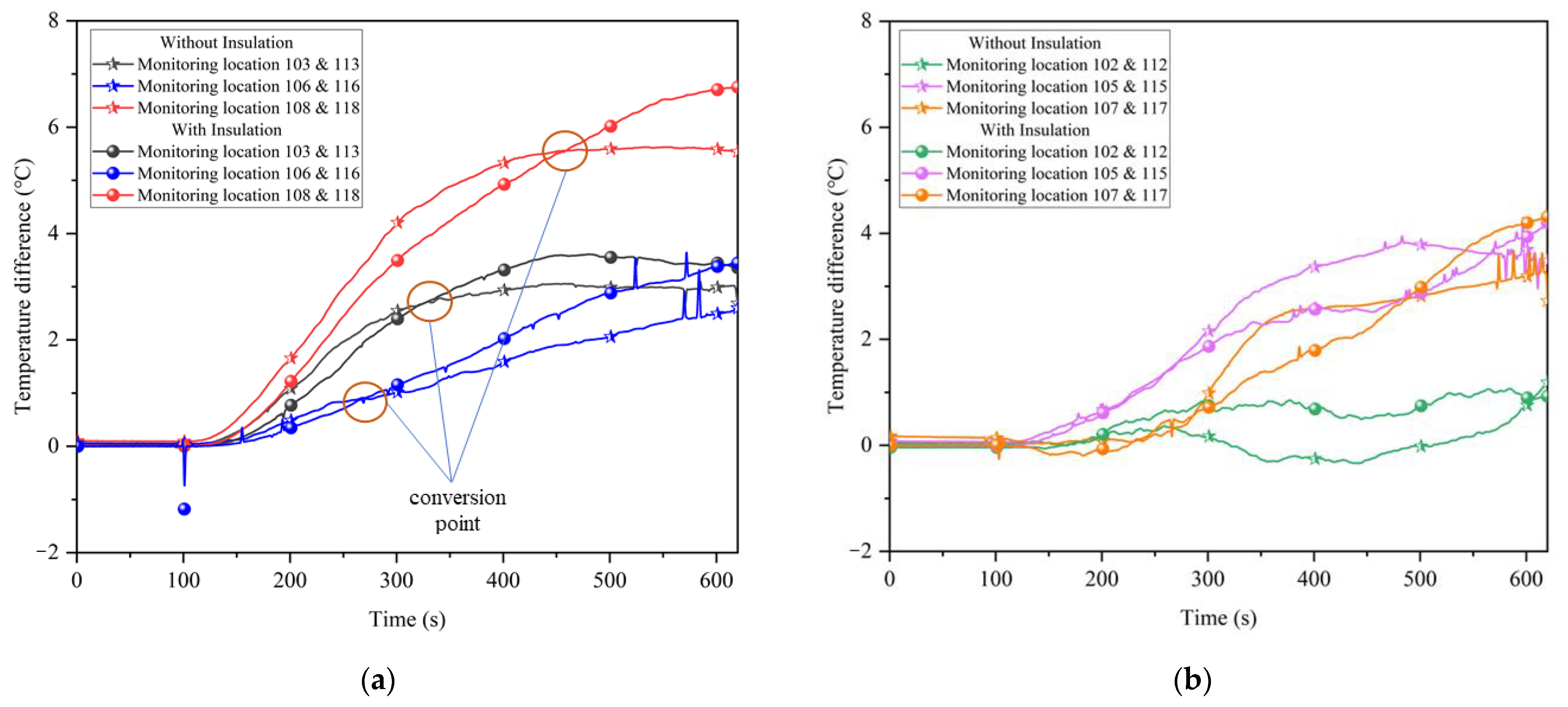

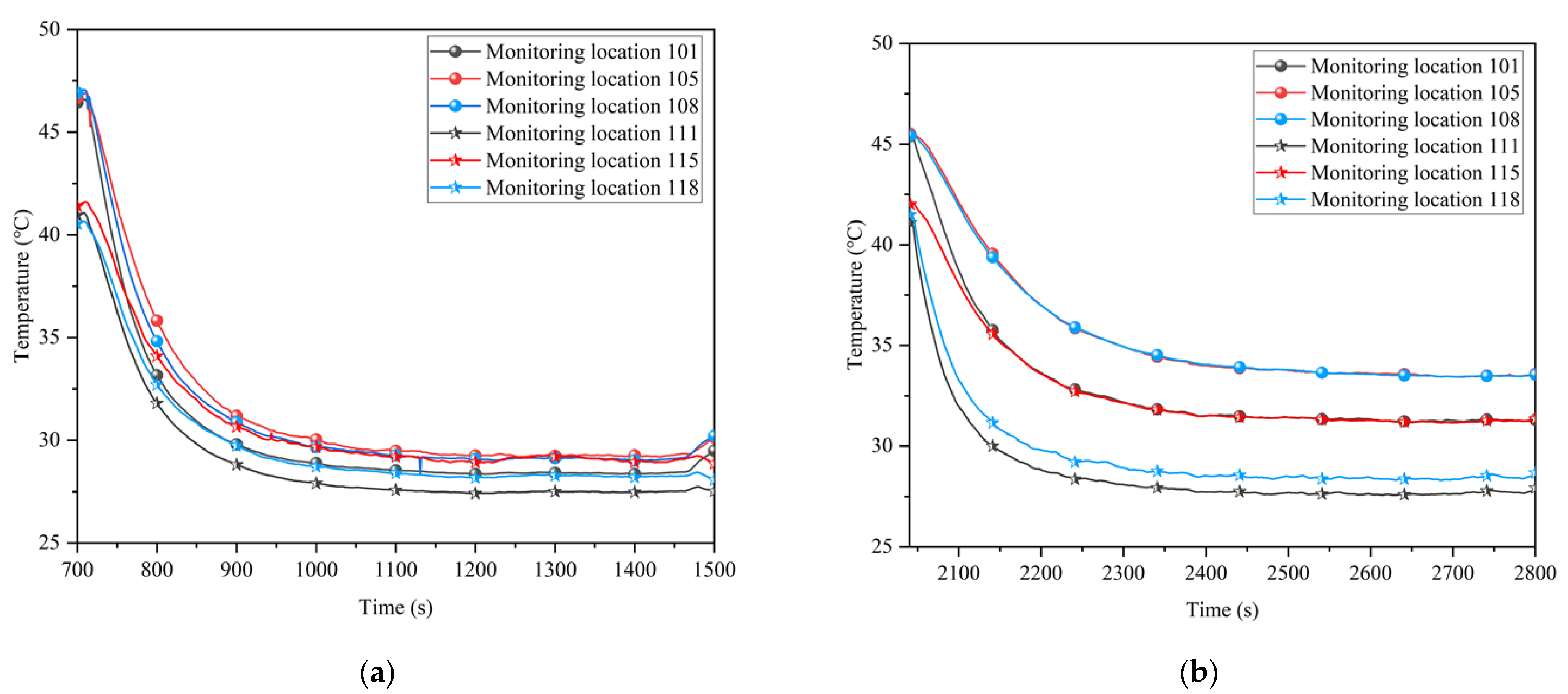
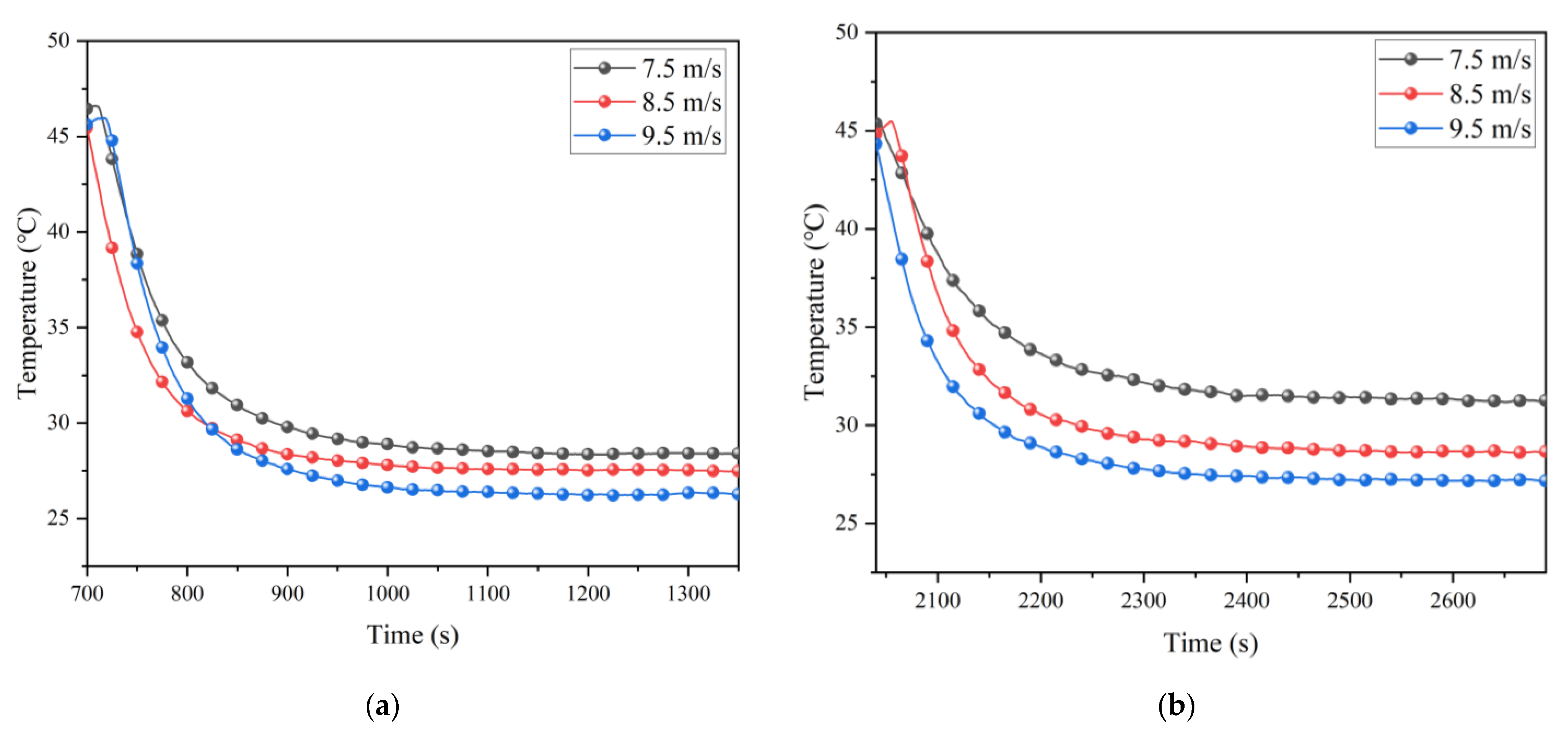
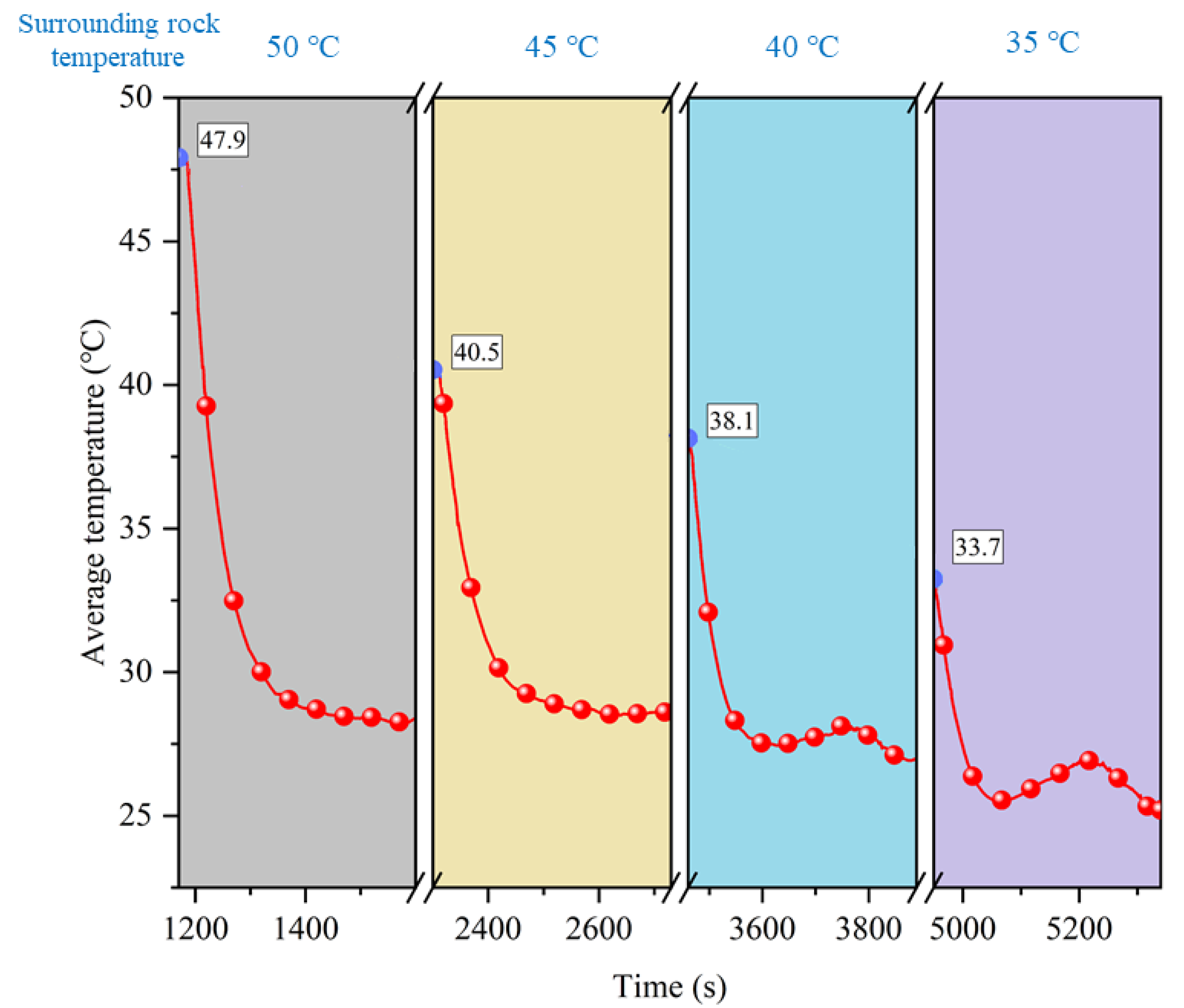
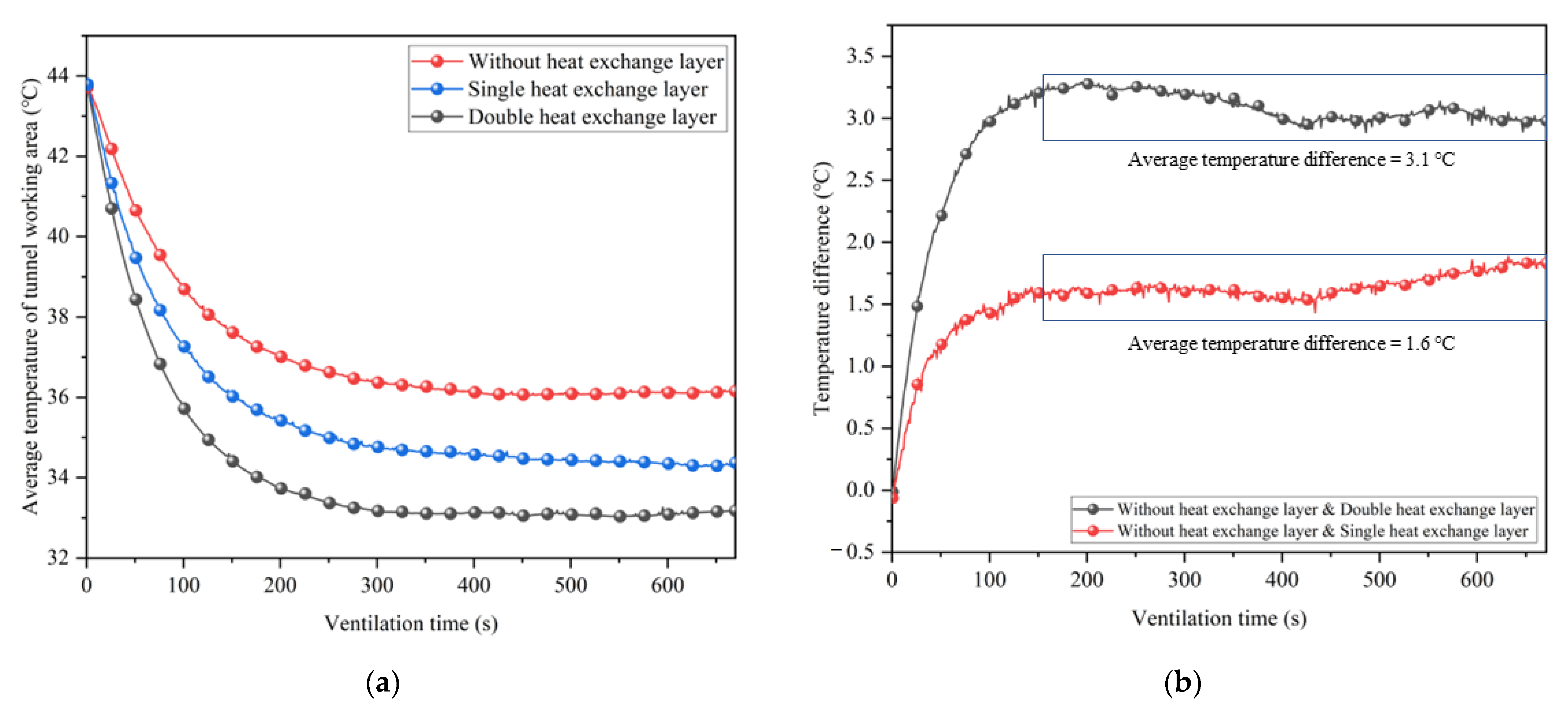
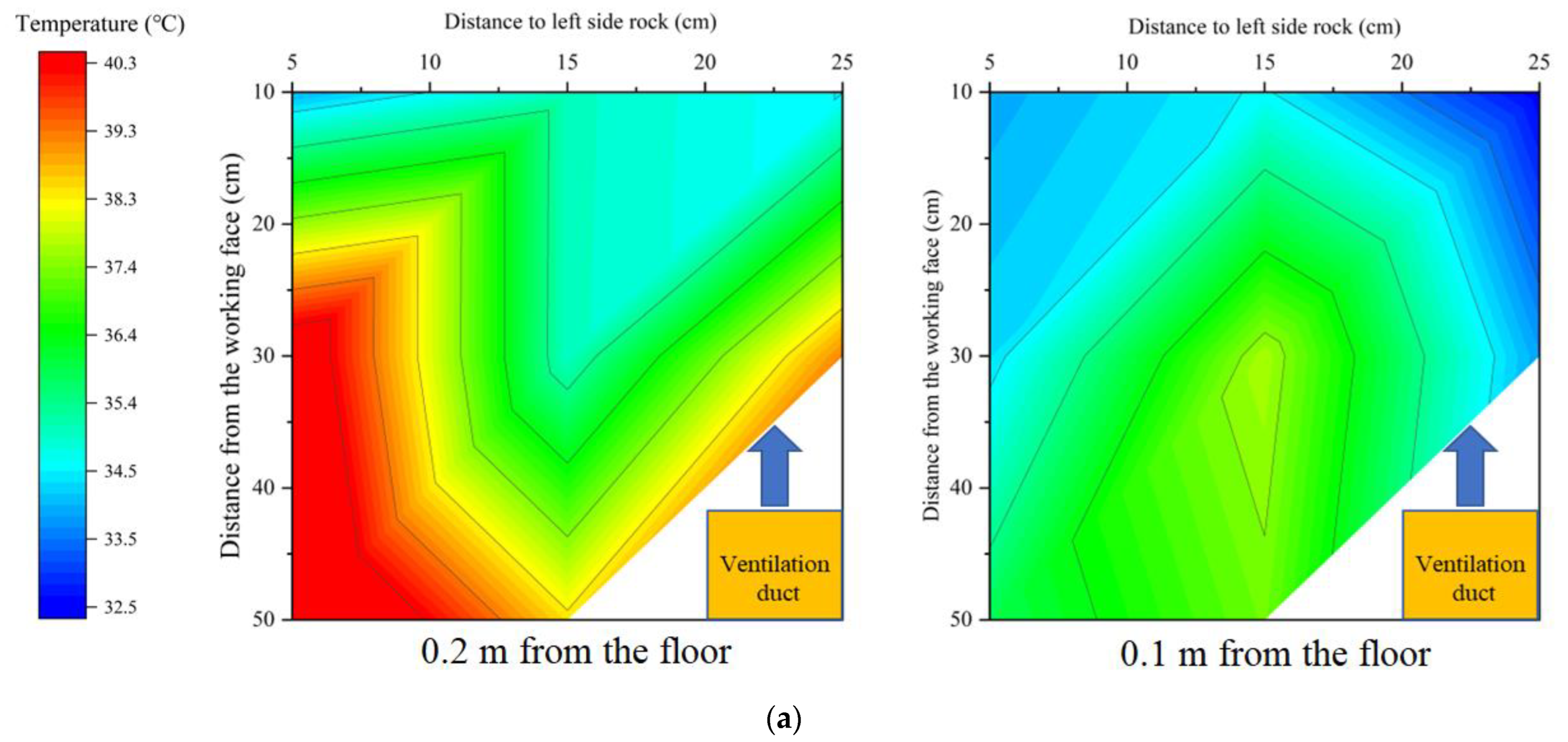

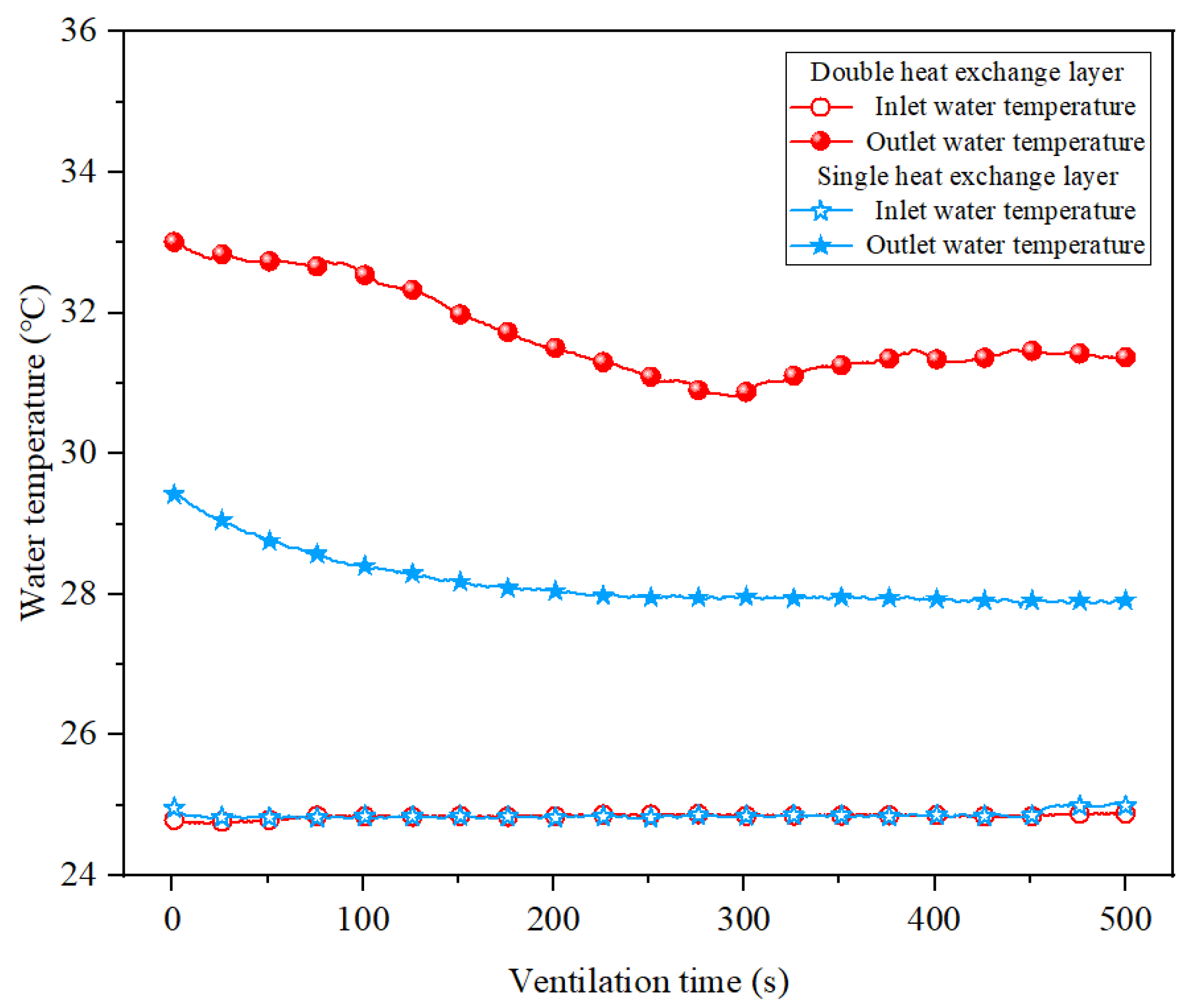
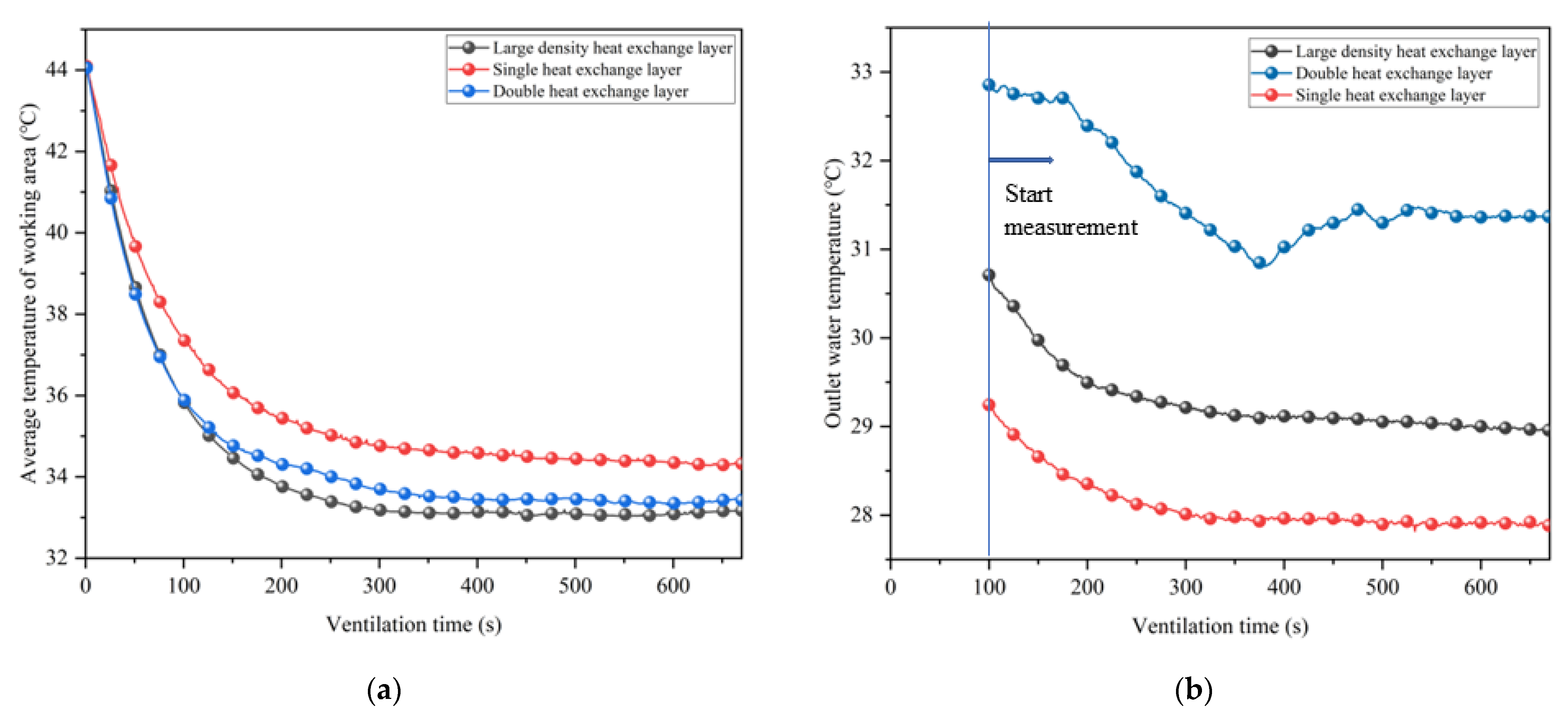
| Parameters | Value |
|---|---|
| Specific heat capacity of rock (J/(kg·°C)) | 1300 |
| Heat conduction coefficient of rock (W/(m·°C)) | 3.5 |
| Density of rock (kg/m3) | 2600 |
| The initial temperature of rock (°C) | 40–45 |
| Similarity Index | Representation |
|---|---|
| Reynolds number | Reflecting the ratio of inertial to viscous forces |
| Archimedes number | Reflecting the ratio of buoyancy to inertia force |
| Grashof number | Reflecting the ratio of buoyancy to viscous force |
| Prandtl number | Reflecting the relationship between momentum transfer and heat transfer |
| Parameter | Symbols | Scale | Relations |
|---|---|---|---|
| Length | Cl = lm:lp | 1:10 | - |
| Volume | Cv = vm:vp | 1:1000 | Cv = Cl3 |
| Velocity | Cu = um:up | 10:1 | - |
| Time | Ct = tm:tp | 1:100 | Ct = Cl/Cv |
| Density | Cρ = ρm:ρp | 1:1 | - |
| Viscosity | Cμ = μm:μp | 1:1 | - |
| Convective heat transfer coefficient | Ch = hm:hp | 10:1 | Ch = Cλ/Cl |
| Thermal conductivity | Cλ = λm:λp | 1:1 | - |
| Specific heat | Ccp = Cpm:Cpp | 1:1 | - |
| Temperature | CT = Tm:Tp | 1:1 | - |
| Grid Number | Air Temperature (°C) | Ventilation Volume (m3/min) |
|---|---|---|
| 1124 | 25.48 | 21.87 |
| 1476 | 25.11 | 21.63 |
| 1723 | 25.79 | 21.63 |
| 2106 | 25.52 | 21.47 |
| 2733 | 25.66 | 21.36 |
| 5585 | 24.35 | 23.11 |
| 13,102 | 24.34 | 23.61 |
| 38,100 | 26.70 | 27.05 |
| 43,072 | 26.72 | 27.17 |
| Monitoring Location Number | Relative Error (%) | Monitoring Location Number | Relative Error (%) |
|---|---|---|---|
| 1 | 2.62 × 10−4 | 21 | −1.22 × 10−2 |
| 2 | −8.70 × 10−4 | 22 | −1.22 × 10−2 |
| 3 | −1.75 × 10−3 | 23 | −1.24 × 10−2 |
| 4 | −2.74 × 10−3 | 24 | −1.24 × 10−2 |
| 5 | −3.71 × 10−3 | 25 | −1.25 × 10−2 |
| 6 | −4.67 × 10−3 | 26 | −1.26 × 10−2 |
| 7 | −5.53 × 10−3 | 27 | −1.32 × 10−2 |
| 8 | −6.44 × 10−3 | 28 | −1.36 × 10−2 |
| 9 | −7.18 × 10−3 | 29 | −1.33 × 10−2 |
| 10 | −8.09 × 10−3 | 30 | −1.34 × 10−2 |
| 11 | −8.75 × 10−3 | 31 | −1.35 × 10−2 |
| 12 | −9.60 × 10−3 | 32 | −1.27 × 10−2 |
| 13 | −1.01 × 10−2 | 33 | −1.18 × 10−2 |
| 14 | −1.06 × 10−2 | 34 | −1.19 × 10−2 |
| 15 | −1.10 × 10−2 | 35 | −1.36 × 10−2 |
| 16 | −1.12 × 10−2 | 36 | −1.45 × 10−2 |
| 17 | −1.14 × 10−2 | 37 | −1.42 × 10−2 |
| 18 | −1.16 × 10−2 | 38 | −1.39 × 10−2 |
| 19 | −1.18 × 10−2 | 39 | −1.36 × 10−2 |
| 20 | −1.20 × 10−2 | 40 | −1.20 × 10−2 |
| Test Number | 1 | 2 | 3 | 4 | 5 | 6 | 7 | 8 | 9 | 10 | 11 | 12 | 13 |
|---|---|---|---|---|---|---|---|---|---|---|---|---|---|
| Ambient temperature (°C) | 16.5 | 16.5 | 16.6 | 16.6 | 16.5 | 17.1 | 16.7 | 16.7 | 17.0 | 16.5 | 16.2 | 16.4 | 16.5 |
Disclaimer/Publisher’s Note: The statements, opinions and data contained in all publications are solely those of the individual author(s) and contributor(s) and not of MDPI and/or the editor(s). MDPI and/or the editor(s) disclaim responsibility for any injury to people or property resulting from any ideas, methods, instructions or products referred to in the content. |
© 2023 by the authors. Licensee MDPI, Basel, Switzerland. This article is an open access article distributed under the terms and conditions of the Creative Commons Attribution (CC BY) license (https://creativecommons.org/licenses/by/4.0/).
Share and Cite
Wang, J.; Li, Z.; Li, G.; Xu, Y. Heat Hazard Control in High-Temperature Tunnels: Experimental Study of Coupled Cooling with Ventilation and Partial Insulation for Synergistic Geothermal Extraction. Int. J. Environ. Res. Public Health 2023, 20, 1941. https://doi.org/10.3390/ijerph20031941
Wang J, Li Z, Li G, Xu Y. Heat Hazard Control in High-Temperature Tunnels: Experimental Study of Coupled Cooling with Ventilation and Partial Insulation for Synergistic Geothermal Extraction. International Journal of Environmental Research and Public Health. 2023; 20(3):1941. https://doi.org/10.3390/ijerph20031941
Chicago/Turabian StyleWang, Junjian, Zijun Li, Gang Li, and Yu Xu. 2023. "Heat Hazard Control in High-Temperature Tunnels: Experimental Study of Coupled Cooling with Ventilation and Partial Insulation for Synergistic Geothermal Extraction" International Journal of Environmental Research and Public Health 20, no. 3: 1941. https://doi.org/10.3390/ijerph20031941
APA StyleWang, J., Li, Z., Li, G., & Xu, Y. (2023). Heat Hazard Control in High-Temperature Tunnels: Experimental Study of Coupled Cooling with Ventilation and Partial Insulation for Synergistic Geothermal Extraction. International Journal of Environmental Research and Public Health, 20(3), 1941. https://doi.org/10.3390/ijerph20031941








